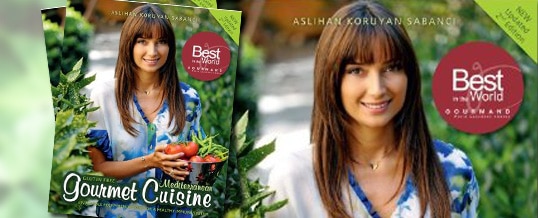Cookbook for Endometriosis

Dr. Seckin believes that following a gluten- and dairy-free, organic diet can help endometriosis patients manage their symptoms. He recently met Aslihan Sabanci, an author, and entrepreneur, who has written an excellent cookbook for endometriosis patients and everyone else who wants to be healthy. Her book’s title is “Gluten-Free, Mediterranean Gourmet Cuisine: Invaluable Recommendations for a Healthy Immune System.”
Mrs. Sabanci was happy to answer questions and give tips on how to start eating gluten-free. She started eating gluten-free many years ago for the benefit of her own health. She wrote this cookbook out of her need to find tasty and practical recipes.
Interview about the cookbook for endometriosis
Q: When you were a little girl, you were experimenting in the kitchen and using your friends and family as taste testers! You take pride in your recipes. How important is it for you that your food not only be gluten-free but taste good?
A: I think it is very important that my recipes taste great. Great-tasting food is the key to eating a well-balanced diet. Don’t forget, if your healthy food does not taste great, you will always prefer fried, super-fattening, and super-tasty unhealthy food over healthy food.
Q: You stress how important it is for your recipe ingredients to be practical. You expressed your frustration in many gluten-free recipes having bizarre, hard-to-find ingredients.
A: Today, especially in big cities like New York and Los Angeles, there are more gluten-free options to choose from. However, many gluten-free ingredients are still hard to find when you are traveling or if you are not living in big cities. That’s why I wanted to use easy-to-find ingredients.
Q: Dr. Seckin believes there is an immunological component to endometriosis. Some women who have endometriosis also suffer from other autoimmune-inflammatory diseases. Women with endometriosis also suffer from chronic fatigue. In your book, you talk about ways to boost your immune system through diet. What is an easy way an endometriosis patient can boost their immune system on a daily basis?
A: To boost the immune system, it is very important to eat a well-balanced diet full of whole foods and plenty of antioxidants. I mention all of these valuable antioxidants, their sources, and how much of them there are in which nutrients in my book.
I worked with an award-winning doctor and a dietitian, and a nutritionist to figure out the antioxidant values of each and every recipe in my book. These doctors then formed charts to graphically present these calculated antioxidant values. This way my readers can be informed about the health benefits of my recipes.
To help boost the immune system, the most valuable antioxidants to consume are fiber, vitamin A, vitamin E, vitamin B1, vitamin B2, niacin, folic acid, vitamin C, calcium, magnesium, iron, and zinc. The most efficient way to increase antioxidant intake is to increase your daily consumption of fruits, vegetables, and legumes. I also dedicated a chapter in my book to these nutrients and their natural resources.
Q: Many women reach for gluten/dairy/sugar-filled foods when they are stressed or when they have their period, which can only inflame their endometriosis. It can be a physiological response, just as much as an emotional one. What is your “go-to” recipe in your book that can replace any chocolate/salty/fried comfort foods?
A: When I am craving chocolate, it usually works for me to eat a handful of pistachios to harness the craving. In addition, fruity desserts are an excellent way to stop cravings for high-calorie desserts. In addition, by consuming fruity desserts you will also get plenty of antioxidants as a bonus! For example, Kabak Tatlisi, a savory and sweet pumpkin dessert, has plenty of vitamin C, A, B1, B2, and magnesium in it.
Q: For a woman who just received a diagnosis of endometriosis, what would be the staple items from the supermarket you would pick up right away to start on a gluten-free diet?
A: Quinoa flour (to make bread or any other pastries), quinoa pasta, or the actual quinoa, all kinds of rice to make a variety of rice dishes, so you do not get bored with cooking only one type of rice (wild rice, basmati rice, risotto rice….) and plenty of fruits and vegetables.
Q: When you first started eating gluten-free, what was the hardest thing to give up?
A: Pastries….
Q: How did eating gluten-free change how you feel?
A: I felt less swollen and bloated. I started fitting into my jeans again.
Q: Gluten-free eating is hard, although your wonderful book makes it easier! What words of encouragement do you have for people taking on gluten-free eating?
A: Do not be scared! Go beyond the books and experiment for yourself. Do not forget to exercise and to get enough sleep. Try to make the best out of it, and have fun!
Mrs. Sabanci’s cookbook is excellent. You can find simple and delicious recipes that are great for the endo diet. Within the pages, one can find a multitude of easy, fresh recipes from guacamole to sesame chicken, to delicious desserts and smoothies. Although some of the recipes contain dairy, many of the dairy ingredients are optional or can easily be substituted with almond milk or Earth Balance. You can find Mrs. Sabanci’s cookbook on Amazon
Get a Second Opinion
Our endometriosis specialists are dedicated to providing patients with expert care. Whether you have been diagnosed or are looking to find a doctor, they are ready to help.Our office is located on 872 Fifth Avenue New York, NY 10065.
You may call us at (646) 960-3080 or have your case reviewed by clicking here.